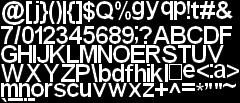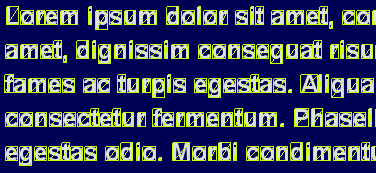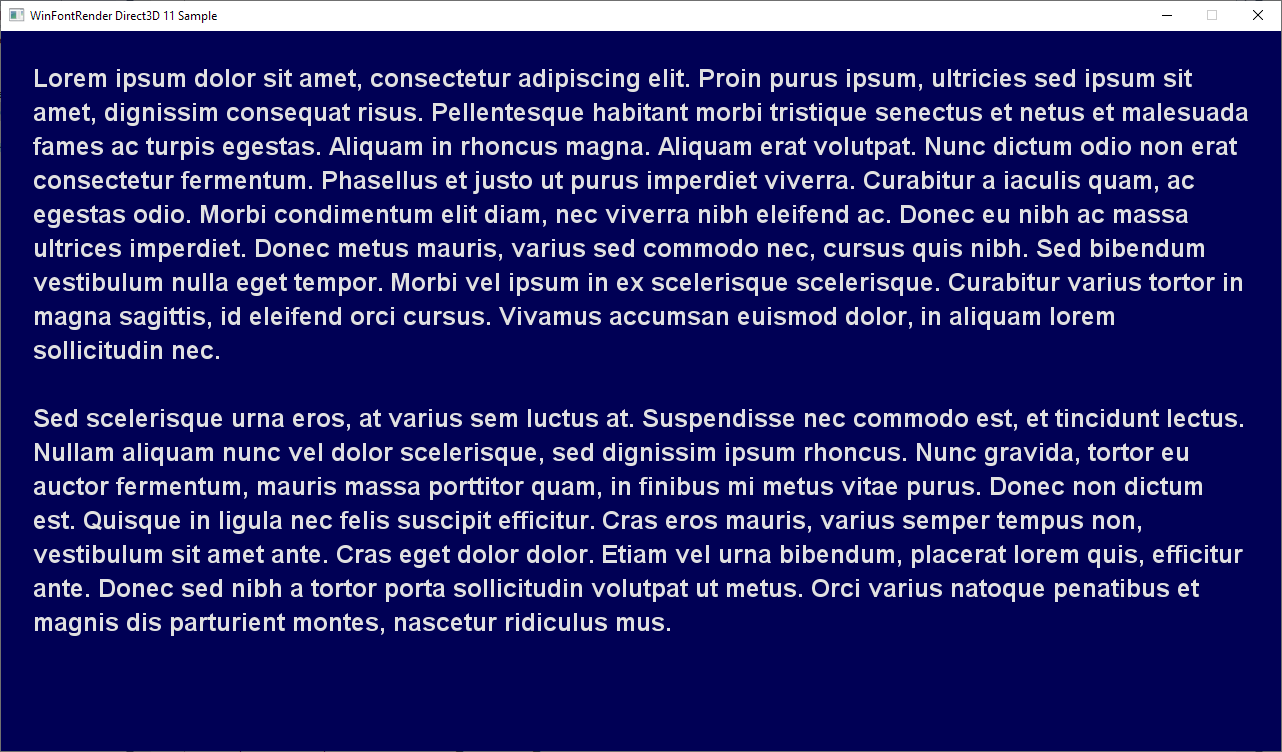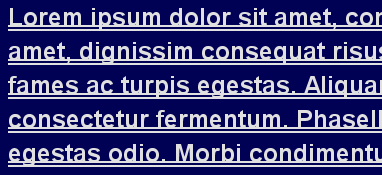Small single-header C++ library that renders Windows fonts in graphics applications.
Author: Adam Sawicki - http://asawicki.info
Version: 1.0.0, 2019-03-14
Documentation: see below and comments in the code of WinFontRender.h file.
While developing various kinds of programs, we often take the possibility of displaying text for granted, as we get this functionality out-of-the-box. This is the case in console apps, where we can just print characters and they are displayed in the terminal. This is also the case in GUI apps (whether made in Windows Forms, WPF, Qt, wxWidgets, MFC) - we have labels, buttons, and other controls available.
However, this is not the case when we develop a graphics program or a game using one of the graphics API like Direct3D, OpenGL, or Vulkan. Then the only thing we can do is rendering triangles covered with textures. That's how graphics cards work after all. Displaying text is challenging in this environment, as every single character has to be turned into a textured quad made of two triangles.
This library provides solution to this problem by implementing a CFont class, which does two things:
-
It renders characters of the font to a texture, tightly packed.
-
It calculates vertices needed to render given text.
-
The library is written in object-oriented C++. No advanced template trickery is used, but some C++11 features may appear.
-
It has form of a single file "WinFontRender.h", which you can just copy to your project. Everything else is example usage code and documentation.
-
It is based on slightly modified MIT license, so it's free to use in any projects, including closed-source, proprietary, and commercial. See LICENSE for details.
-
It depends only on standard C and C++ library (including some basic STL -
std::vector,std::wstring) and WinAPI (Windows.h). -
It is agnostic to graphics API. It only provides CPU buffer with data that you need to upload to the GPU as a texture, and fills your CPU buffer with data that you need to render as vertex and index buffer. It is your responsibility to do actual rendering using API of your choice, whether it's Direct3D 9, 11, 12, OpenGL, or Vulkan.
-
It uses a font installed in the system, based on given name and other parameters (e.g. "Arial", size = 32, bold). It cannot load fonts from existing textures or standalone font files. If you need the latter, FreeType is a popular library for this.
-
It is intended for usage on Windows only. Linux, MacOS, Android, or any other platforms are not supported.
-
It is developed and tested in Microsoft Visual Studio 2017 in 64-bit configuration. Theoretically it should work in 32-bit configuration or with other compilers.
-
It uses Unicode strings, like
const wchar_t*orstd::wstring. If you prefer ANSI or UTF-8, you need to convert them first, e.g. using WinAPI functionMultiByteToWideChar. -
Example project is included that demonstrates usage of the library in a simple Direct3D 11 application:
"Single header" doesn't mean everything is contained in function declarations, like it tends to be in case of inline functions or C++ templates. It means that implementation is bundled with interface in a single file and needs to be extracted using a preprocessor macro. If you don't do it properly, you will get linker errors.
To do it properly:
- Include "WinFontRender.h" file in each CPP file where you want to use the library. This includes declarations of all public members of the library.
- In exacly one CPP file define following macro before this include. It enables internal implementation (function definitions).
#define WIN_FONT_RENDER_IMPLEMENTATION
#include "WinFontRender.h"It may be a good idea to create dedicated CPP file just for this purpose.
The library defines two sets of helpers types. First one includes wstr_view type, which represents a view into an existing Unicode string. It is actually a copy of my another library called str_view - "Null-termination-aware string-view class for C++". I encourage you to take a look at it. You may find it useful. If you don't care, please just remember that parameters of type wstr_view support implicit conversion from null-terminated strings const wchar_t*, as well as std::wstring.
All symbols other than the string view mentioned above are defined in namespace WinFontRender.
Second set of helper types are very simple vector structures: bvec2, bvec4 (for bool), ivec2, ivec4 (for int32_t), uvec2, uvec4 (for uint32_t) and vec2, vec4 (for float). Basic thing to remember about them is that you can construct them by either specifying separate components, like vec2(1.0f, 2.0f), or by passing pointer to the array of components.
CFont* font = new CFont();
SFontDesc fontDesc;
fontDesc.FaceName = L"Arial";
fontDesc.Height = 30;
fontDesc.Flags = SFontDesc::FLAG_BOLD;
font->Init(fontDesc);FaceNamemust be name of font installed in the system.Heightis font size, in pixels.Flagscan include flags fromSFontDesc::FLAGSenum, e.g.SFontDesc::FLAG_BOLD,SFontDesc::FLAG_ITALIC.
Don't forget to delete font at the end.
Texture data is stored inside CFont object. You can query for it and use it to create a texture in your graphics API. You can then tell the font to free the data.
uvec2 size;
size_t rowPitch;
const void* data;
font->GetTextureData(data, size, rowPitch);
CD3D11_TEXTURE2D_DESC textureDesc = CD3D11_TEXTURE2D_DESC(
DXGI_FORMAT_A8_UNORM, size.x, size.y, 1, 1, D3D11_BIND_SHADER_RESOURCE, D3D11_USAGE_IMMUTABLE);
D3D11_SUBRESOURCE_DATA initialData = {data, (UINT)rowPitch, 0};
ID3D11Texture* texture;
d3d11Device->CreateTexture2D(&textureDesc, &initialData, &texture);
font->FreeTextureData();You can use your own vertex structure. You need to allocate vertex and optional index buffer and pass their parameters to the font, so they can be filled with data for given text.
struct SVertex
{
vec2 Pos;
vec2 TexCoord;
};
// Index buffer not used in this example. See sample project for example of index buffer usage.
constexpr vbFlags = VERTEX_BUFFER_FLAG_TRIANGLE_LIST;
// (...)
const wchar_t* text = /* ... */
const float fontSize = 32.0f;
const uint32_t flags = CFont::FLAG_WRAP_WORD | CFont::FLAG_HLEFT | CFont::FLAG_VTOP;
const vec2 leftTopPosition = vec2(8.f, 8.f);
const float textWidth = 512.0f;
const size_t quadCount = m_Font->CalcQuadCount(text, fontSize, flags, textWidth);
size_t vertexCount, indexCount;
QuadCountToVertexCount<vbFlags>(vertexCount, indexCount, quadCount);
std::vector<SVertex> vertices(vertexCount);
SVertexBufferDesc vbDesc;
vbDesc.FirstPosition = &vertices[0].Pos;
vbDesc.FirstTexCoord = &vertices[0].TexCoord;
vbDesc.PositionStrideBytes = sizeof(SVertex);
vbDesc.TexCoordStrideBytes = sizeof(SVertex);
vbDesc.FirstIndex = nullptr;
font->GetTextVertices<vbFlags>(vbDesc, leftTopPosition, text, fontSize, flags, textWidth);
// (...)
// Upload vertices to the GPU and set as vertex buffer. Finally:
d3d11Context->IASetPrimitiveTopology(D3D11_PRIMITIVE_TOPOLOGY_TRIANGLELIST);
d3d11Context->Draw((UINT)vertexCount, 0);Multiline text is supported with explicit line breaks on '\n', "\r\n", as well as automatic wrap on whole word boundaries (with CFont::FLAG_WRAP_WORD used) or single character boundaries (with CFont::FLAG_WRAP_CHAR used) when text width is limited.
Horizontal and vertical alignment is supported to left/center/right and top/middle/bottom. Use flags CFont::FLAG_HLEFT, CFont::FLAG_HCENTER, CFont::FLAG_HRIGHT, CFont::FLAG_VTOP, CFont::FLAG_VMIDDLE, CFont::FLAG_VBOTTOM.
Vertex format is flexible. Positions and texture coordinates must be pairs of floats. You can fill structure SVertexBufferDesc with parameters describing your positions and texture coordinates laid out in the same or separate streams and with any vertex strides.
Various vertex topologies are supported. By using VERTEX_BUFFER_FLAG_* flags, you can request vertices generated as triangle list, triangle strip with primitive restart index, or triangle strip with degenerate triangles. You can also use 16-bit indices, 32-bit indices, or no index buffer. These flags need to be known at compile time because they are template parameter, for performance reason.
Vertex positions are assumed to be expressed in pixels, from left-top as (0, 0). All triangles have clockwise winding.
Texture coordinates are configurable. By default a coordinate system is assumed that samples textures from left-top as (0, 0), like in DirectX or Vulkan. You can use SFontDesc::FLAG_TEXTURE_FROM_LEFT_BOTTOM to change it to a coordinate system where textures are sampled from left-bottom as (0, 0), like in OpenGL.
Texture format is always single component, 8 bits per pixel. It can be interpreted as DXGI_FORMAT_R8_UNORM or DXGI_FORMAT_A8_UNORM.
Among various advanced font features, the library supports kerning, which is handled automatically. It doesn't support ligatures, colourful emoji, right-to-left or other complex writing systems like Hindi, Arabic, Hebrew etc.
Fonts use antialiasing, which means edges are smoothed with many shaders of gray, not just 0 or 1. Sub-pixels antialiasing (on the level of separate RGB monitor subpixels) is not supported.
Fonts are pixel-perfect, which means they are not scaled and filtered, as long as you use the same value as fontSize parameter while rendering and SFontDesc::Height while creating the font. It makes even small fonts looking quite good and clear.
Underlines can be added using CFont::FLAG_* flags in many flavors - as CFont::FLAG_UNDERLINE, CFont::FLAG_OVERLINE, CFont::FLAG_STRIKEOUT, and even CFont::FLAG_DOUBLE_UNDERLINE:
Not all 65536 Unicode characters are rendered to texture. By default these are only characters in range 32..127. It means traditional ANSI - it covers Latin letters and the symbols that are on your keyboard. You can choose which ones are rendered to support diacritic letters of your language or some other symbols that you need. To do it, you need to specify custom character ranges (pairs of characters) when initializing a font:
const wchar_t charRanges[] = {
// Default range
32, 127,
// Polish diacritics
0x0104, 0x0105,
0x0106, 0x0107,
0x0118, 0x0119,
0x0141, 0x0142,
0x0143, 0x0144,
0x00D3, 0x00D3,
0x00F3, 0x00F3,
0x015A, 0x015B,
0x0179, 0x017C,
// German diacritics
0x00C4, 0x00C4,
0x00D6, 0x00D6,
0x00DC, 0x00DC,
0x00DF, 0x00DF,
0x00E4, 0x00E4,
0x00F6, 0x00F6,
0x00FC, 0x00FC,
};
SFontDesc fontDesc;
fontDesc.FaceName = L"Arial";
fontDesc.Height = 30;
fontDesc.Flags = SFontDesc::FLAG_BOLD;
fontDesc.CharRangeCount = _countof(charRanges) / 2;
fontDesc.CharRanges = charRanges;
font->Init(fontDesc);Hit testing is available. Methods CFont::HitTestSingleLine and CFont::HitTest provide a test of point (e.g. mouse cursor position) against text. They return index of the character that is hit at this point.
Error handling is very simple. It doesn't use C++ exceptions. The only function that can fail is CFont::Init. It just returns bool.
Performance of vertex generation should be quite good, suitable for calling every frame. CFont::FLAG_WRAP_SINGLE_LINE is the fastest mode, and so are the functions with "SingleLine" in their names. CFont::FLAG_VMIDDLE and CFont::FLAG_VBOTTOM are slow.
Thread safety is ensured as there is no unexpected global state. Different objects of CFont class can be created by different threads and used simultaneously. Calling const methods of a single CFont object from different threads simultaneously is also safe.





